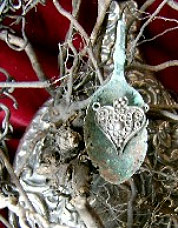
| HOME |
| NERVE |
| REVIEWS |
| ARCHIVE |
| EVENTS |
| LINKS |
| ABOUT US |
| CONTRIBUTORS |
| BACK ISSUES |
| CONTACT US |
 What
Big Eyes You Have
What
Big Eyes You Have
Elizabeth Willow and Becca Backhouse
Cornerstone Gallery, Hope @ Everton
20th January – 17th February 2006
Reviewed by Helen Grey
Beneath the story, within the pages of the
red and gold-chased book, between the words of the story teller sitting
close by the late burning fire, there lies a tangle of roots, vast and
intricate.
Elizabeth Willow
On display at the Cornerstone Gallery (found in the entrance of Liverpool Hope’s Everton campus) is a collection of magical work presented by the artists Elizabeth Willow and Becca Backhouse. Through a mixture of chalk drawings, objects and photos the artists explore the ideas of “power, sacrifice and transformation” in the world of fairytales, according to the gallery’s curator Jason Jones. Though each artist created the majority of their pieces alone, the work is tied together through a shared fascination with the symbols, themes and characters attributed to the realm of fairy tales - with particular emphasis on the story of Little Red Riding Hood. Becca Backhouse - whose work considers a set of ideas based on various translations of Little Red Riding Hood - said: “One way in which our work is linked is by the presence of the wolf, sometimes visible, other times it is there by inference. Our work plays with the ambiguity of who the real wolf is and just who poses the threat.”
There is a darkness present in the collection. It oozes from a dark wardrobe and chest of draws containing black apples, reminiscent of the poison fruit given to Snow White. Elizabeth Willow combines natural materials, bark, twigs and berries, with man-made items, including books, spectacles and a spoon. They draw upon the idea of the reader becoming lost within the story just as Little Red Riding Hood becomes lost in the forest, amongst its misleading paths and hidden dangers. Stand and look at them long enough and you could be transported into another world teeming with excitement and mystery.
The large chalk drawings feature stark images of a wolf-like figure surrounded by indecipherable words. Backhouse explained how she used this medium to explore transformation within the stories and the manipulation that can occur through the hands of authors and readers. Unfortunately I found the drawings a little flat, and felt disappointed at myself for not seeing Becca’s points and at Becca for not conveying them.
The high volume of artistic commentary and intervention was a recurring problem of the whole exhibition. Several paragraphs written by (I assume) the curator, detailing the influences and inspirations of the artists, combined with further commentary by the artists themselves, steered me to a specific viewing of the work. Becca Backhouse spoke of how the rendition of Little Red Riding Hood by the Grimm Brothers “compounds myths about women, they should not stray from the path, they should fear being alone and are to blame if they are attacked.’
It is ironic then that artists do just that, keep the viewer on a set path. Little if no room is left for autonomous responses to the work. Unfortunately, the intended messages were often a little obscure, while the artists’ insistence upon such meanings could prevent the viewer from drawing conclusions that are unique and relevant to their own lives. I left feeling that if I did not look at the pieces and see exactly what the artists wanted me to, I was somehow missing the point.
Printer friendly page